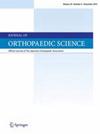日本七家教学机构对9135名使用埃克塞特髋关节柄的患者进行了为期12年的随访研究,结果发现四例髋关节柄骨折。
IF 1.5
4区 医学
Q3 ORTHOPEDICS
引用次数: 0
摘要
背景:尽管有报道称埃克塞特手术柄的长期效果极佳,但手术柄骨折被认为是一种罕见的并发症。然而,目前还没有基于详细人口信息的茎干骨折发生率和风险因素的报告。本研究旨在根据日本七个埃克塞特髋关节柄教学中心的详细人群信息,明确埃克塞特髋关节柄骨折的发生率,并研究柄骨折的风险因素:方法:纳入1999年至2021年间在七家埃克塞特教学医院进行的8499例初次全髋关节置换术(THA)和636例翻修髋关节置换术(revisions),并根据医疗记录进行回顾性调查:在两例初次髋关节置换术(骨折率:0.02%)和两例翻修髋关节置换术(骨折率:0.21%)中发现了髋关节柄骨折。在这四例病例中,有三例的骨干长度≤125毫米。翻修和30个柄是柄骨折的风险因素。体重和体重指数(BMI)与骨干骨折的发生无明显关系:据报道,在西方国家,初级THA的Exeter柄骨折发生率为0.017-0.15%,翻修THA的发生率为0.99-1.21%。在这项研究中,初次THA的发生率为0.02%,与报告的最低发生率相似,而翻修THA的发生率为0.21%,低于以往研究的报告。翻修手术的风险因素与西方报道的相同--即茎干长度≤125毫米(30茎干除外)和体重指数,这在日本患者中并非风险因素。本文章由计算机程序翻译,如有差异,请以英文原文为准。
Four stem fractures in a 12-year follow-up study of 9,135 patients with Exeter hip stems at seven teaching facilities in Japan
Background
Although excellent long-term results have been reported for the Exeter stem, stem fracture is recognized as a rare complication. However, there have been no reports on the incidence and risk factors for stem fractures based on detailed population information. This study aimed to clarify the incidence of Exeter hip stem fracture based on detailed population information from seven Exeter stem teaching centers in Japan and to examine the risk factors for stem fracture.
Methods
A total of 8,499 primary total hip arthroplasties (THA) and 636 revision hip arthroplasties (revisions) performed at seven Exeter teaching hospitals between 1999 and 2021 were included and retrospectively investigated based on medical records.
Results
Stem fractures were identified in two primary THA (fracture rate: 0.02%) and two revision THA (fracture rate: 0.21%) cases. The stem length was ≤125 mm in three out of these four cases. Revision and 30 stem were the risk factors for stem fractures. Weight and body mass index (BMI) were not significantly associated with the occurrence of stem fractures.
Conclusions
In Western countries, the incidence of Exeter stem fractures is reportedly 0.017−0.15% for primary THA and 0.99−1.21% for revision THA. In this study, the incidence of primary THA was 0.02%, which is similar to the lowest reported rate, whereas the incidence of revision THA was 0.21%, which is lower than that reported in previous studies. Revision surgery had the same risk factors as those reported in the West—namely, stem length ≤125 mm (except for the 30 stem) and BMI, which were not risk factors in Japanese patients.
求助全文
通过发布文献求助,成功后即可免费获取论文全文。
去求助
来源期刊

Journal of Orthopaedic Science
医学-整形外科
CiteScore
3.00
自引率
0.00%
发文量
290
审稿时长
90 days
期刊介绍:
The Journal of Orthopaedic Science is the official peer-reviewed journal of the Japanese Orthopaedic Association. The journal publishes the latest researches and topical debates in all fields of clinical and experimental orthopaedics, including musculoskeletal medicine, sports medicine, locomotive syndrome, trauma, paediatrics, oncology and biomaterials, as well as basic researches.
 求助内容:
求助内容: 应助结果提醒方式:
应助结果提醒方式:


